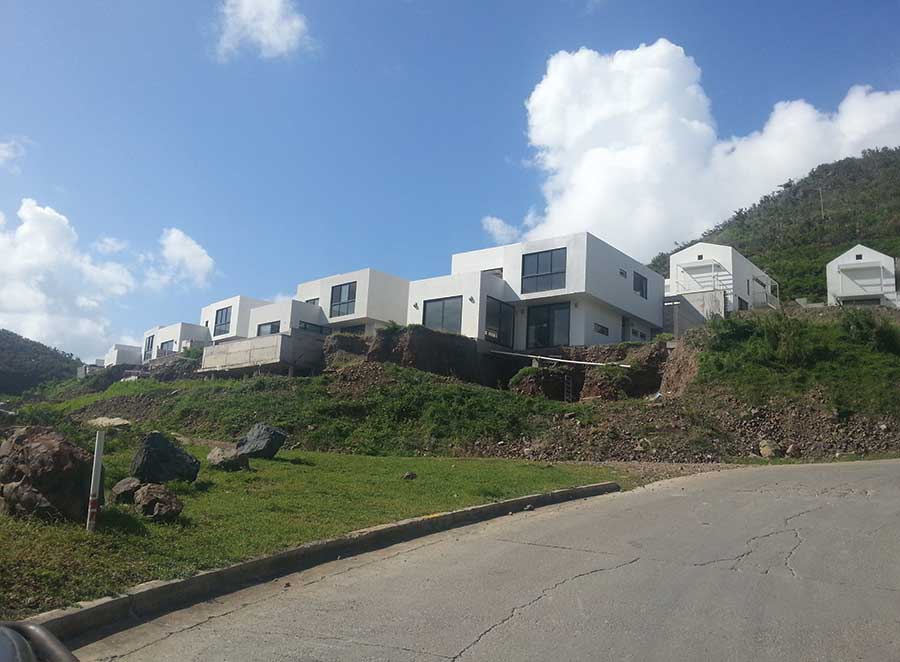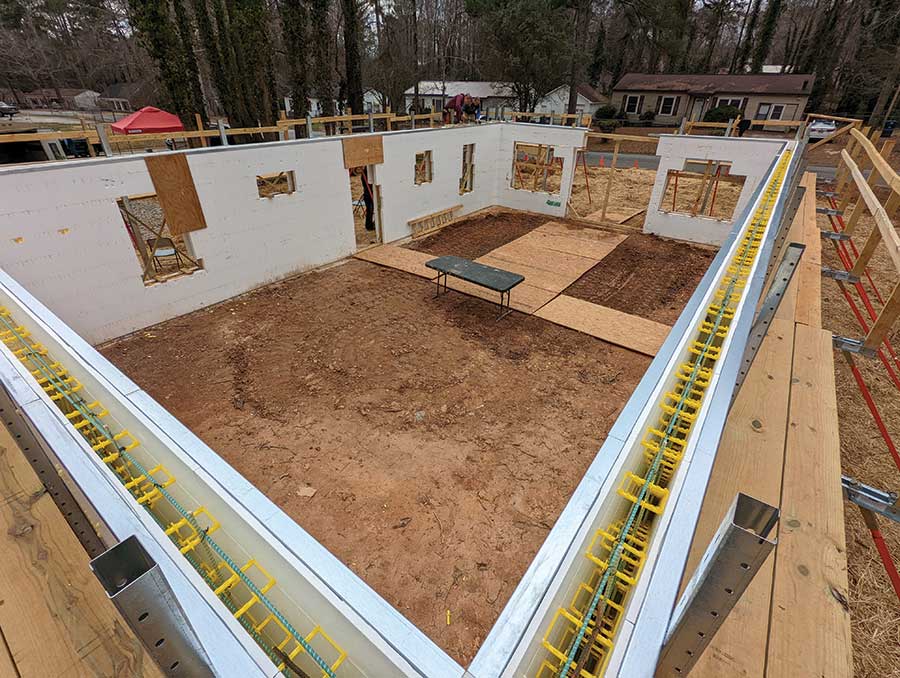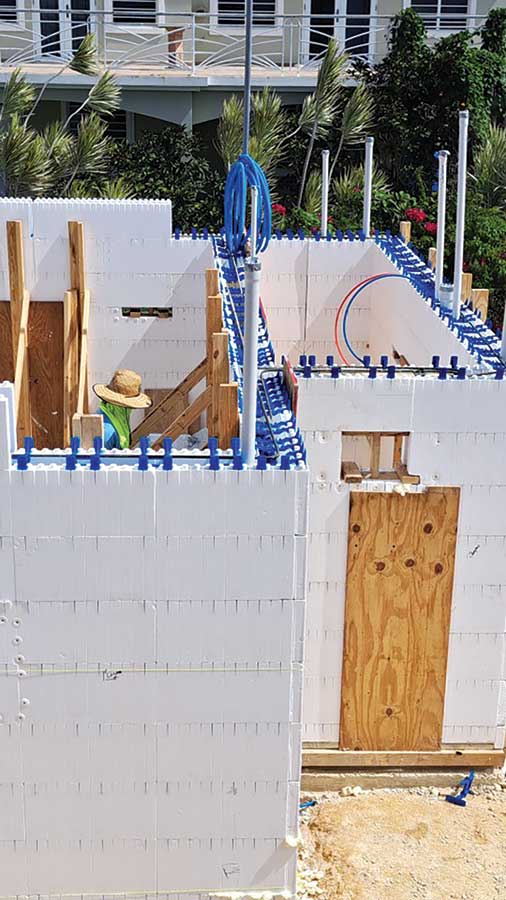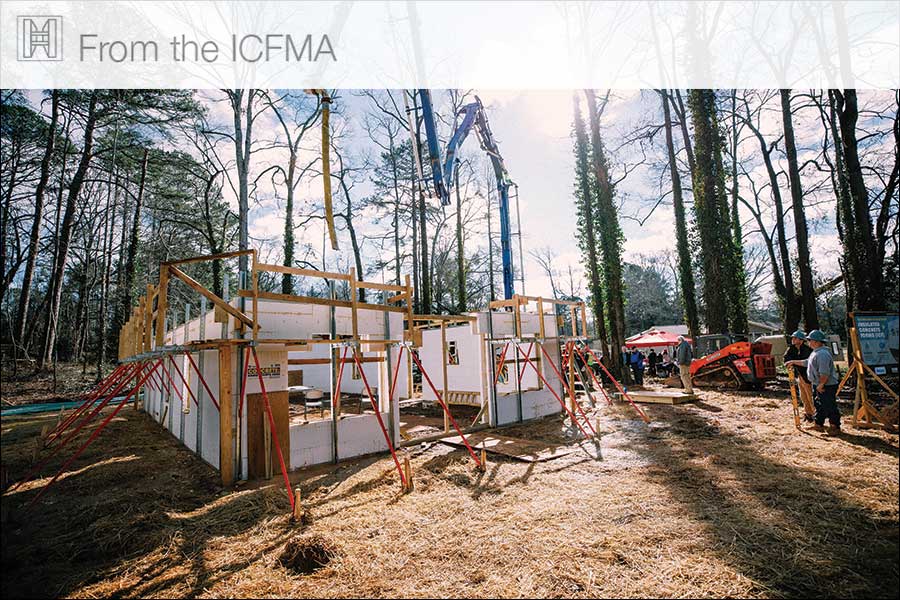By Alysha Campbell, Marketing Manager for Airfoam Industries/Quad-Lock ICF
As natural disasters become increasingly frequent and severe, the need for resilient building solutions has never been more pressing. Insulated Concrete Forms (ICFs) have emerged as a leading technology in constructing buildings that can endure the harshest elements Mother Nature has to offer. From high winds and seismic forces to fire and impact resistance, ICF structures provide unparalleled protection, ensuring safety and longevity.
Unmatched Wind Resistance
One of the standout features of ICF buildings is their ability to withstand extreme wind forces. Traditional wood-framed structures are often vulnerable in the face of hurricanes and tornadoes, but ICF walls can endure winds of up to 250 mph (402 kph). This exceptional resilience is due to the steel-reinforced concrete core that is encased by continuous insulation on both sides of the concrete wall. This robust construction not only maintains the structural integrity of a building during severe storms but also significantly reduces the risk of collapse.

ICF buildings stand unharmed by Hurricane Irma in 2017, which had winds as high as 180 mph in St. Maarten.
The threat posed by high winds is not just theoretical; it is a real and present danger in many parts of the world. In the United States, for example, the frequency of tornadoes and hurricanes is rising, causing billions of dollars in damage each year. Buildings constructed with ICFs have been shown to survive these events with minimal damage, offering peace of mind to homeowners and businesses alike. In coastal areas particularly prone to hurricanes and flooding, ICF construction is becoming a preferred choice due to its proven performance in real-world conditions.
Superior Fire Protection
Fire resistance is another critical advantage of ICF construction. In the event of a wildfire, every second counts, and the materials used in building structures can make a significant difference. ICF walls offer a fire resistance rating of up to 4 hours, compared to the mere 45-minute rating of traditional wood framing. This extended protection provides invaluable additional time for evacuation and can be the difference between life and death. The passive fire protection inherent in ICFs ensures that buildings are better equipped to shield occupants and property from the rapid spread of flames.

ICF walls with an 8-inch concrete core have a 4-hour burn rating.
Wildfires have devastated communities around the world, from the hills of California to the forests of Australia. The increasing prevalence of such fires underscores the need for building materials that can withstand prolonged exposure to intense heat. The concrete core
of an ICF provides a robust defense against fire. This fire-resistant, non-combustible characteristic of concrete not only protects the structure itself but also reduces the risk of fire spreading to neighboring buildings, enhancing overall community safety.
Protection from Weather Extremes
The capacity of high-mass ICF/concrete walls to store and later release heat energy could be a lifesaver in the event of catastrophic power loss in freezing conditions. Recent studies have demonstrated that the ICF building shell contributes heat to the living space for up to 6 days versus as little as 5 hours for conventional wood-framed buildings, without additional heating energy. This added window of safety and protection from the elements could allow critical shelter and time for arrival of assistance for vulnerable building occupants.
Seismic and Impact Resistance
ICF buildings can also be designed to withstand the powerful forces generated by earthquakes and extreme weather events. This reinforced concrete wall assembly provides superior resilience and impact resistance from wind-blown debris. This combination of materials offers a level of durability and strength that traditional construction methods cannot match. In regions prone to seismic activity, ICF structures are particularly advantageous as they meet or exceed stringent building and design requirements, ensuring that they remain standing even during significant tremors. Building codes are typically concerned with structural design that is focused on life safety and not the preservation of the building. ICF/concrete structure designs can easily meet “post-disaster” design requirements which focus on the serviceability of the building following a disaster.
Earthquakes pose a unique set of challenges for building designers, as the ground motion can exert tremendous stress on structures. The ductility and strength of ICF walls allow them to absorb and dissipate these forces more effectively than rigid traditional walls. Case studies from earthquake-prone regions, such as Japan and California, have demonstrated that ICF buildings are more likely to remain intact and habitable after an earthquake, reducing the need for costly repairs and reconstruction. A recent study comparing multi-family buildings constructed with wood and steel framing to ICF-reinforced concrete designs showed the concrete buildings to be back in service in a fraction of the time required for competing materials.
Long-Term Durability and Cost Efficiency
The long-term benefits of ICF construction extend beyond immediate disaster resilience. The durability of insulated concrete form walls means they are less likely to require repairs or rebuilding after normal wear and tear from the forces of nature, resulting in substantial cost savings over time. This durability is coupled with energy efficiency, as the continuous insulation provided by ICFs enhances thermal performance, reducing heating and cooling costs over the service life of the structure.
ICF structures are not only durable but also sustainable. The energy efficiency of ICF walls contributes to lower carbon footprints for buildings, aligning with global efforts to reduce greenhouse gas emissions. Furthermore, the longevity of ICF buildings means fewer resources are needed for maintenance and reconstruction, making them an environmentally responsible choice.

Financial and Human Costs of Natural Disasters
The rising frequency of natural disasters brings not only financial burdens but also human risks. Recent statistics highlight the significant costs associated with repairing property damage from such events. Investing in resilient construction methods like ICFs can mitigate these costs and, more importantly, protect human lives. The robust nature of ICF buildings ensures that they are not only a smart financial investment but also a crucial step towards safeguarding communities against the devastating impacts of natural disasters.
Natural disasters impose a heavy toll on society, both economically and emotionally. The disruption caused by events such as hurricanes, wildfires, tornados, and earthquakes can displace families, disrupt businesses, and strain emergency services. By building with ICFs, communities can reduce the vulnerability of their infrastructure, enhancing their ability to recover quickly from disasters, thus getting people’s lives back on track. This resilience is not just about protecting physical structures but also about preserving the social and economic fabric of affected areas.
Think to the Future
In the face of increasingly unpredictable and severe natural disasters, the need for resilient building solutions is paramount. Insulated Concrete Forms (ICFs) offer unmatched protection against high winds, fires, seismic forces, and impact from flying debris. By choosing ICF construction, contractors and building owners can ensure that their structures stand strong against nature’s fury, providing safety, longevity, and peace of mind. Investing in ICF technology is not just a choice for today but a commitment to building a safer and more resilient future.
As we look ahead, the importance of disaster-resilient construction will only grow. Climate change is expected to increase the frequency and intensity of extreme weather events, making it essential to adopt building practices that can withstand these challenges. ICF technology, with its proven history and versatile applications, represents a forward-thinking approach to construction that prioritizes safety, durability, and sustainability. Whether you are constructing a new home, a commercial building, or a community facility, choosing Insulating Concrete Forms is a smart investment in the future.









Trackbacks/Pingbacks